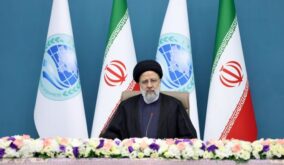Al-Monitor — The Iranian government presented to parliament this month a swollen budget bill for the next Persian year, starting in March 2023. While the draft plan envisages huge boosts of up to 50% in security, intelligence and media spending, the share of tackling air pollution is reduced to half from roughly $8 million to $4 million.
The cut specifically targets the Clean Air Law (CAL). It came into force in 2017 under then-moderate President Hassan Rouhani and remains the sole robust regulation focused on the environment.
“CAL was the result of global expertise and domestic experience … its enforcement requires the necessary budget. Why is it halved as we hit records in pollution intensity?” asked Masoumeh Ebtekar, a former Department of Environment head.
The 34-article law commits at least 20 ministries and state organizations to execute the obligations that range from renovating the public transportation network and fuel consumption checks to punitive measures against violators.
“It is impossible to say a government prioritizes anti-pollution efforts but refrains from appropriations,” air pollution researcher Behzad Ashjaee told the Iranian daily Resalat. “The amount given to countering emissions is nothing compared to the problem scale. The decision exposes contradictions between promises and actions,” said the former member of the National Working Group on Air Pollution.
Simple calculations reveal the CAL quota falls below 0.01% of the whole proposed plan despite a 40% increase in the budget ceiling for next year.
In response to the criticism, head of Iran’s Department of Environment Ali Salajagheh said apart from the proposed budget, 20% of the green tax obtained from industries would be utilized to address air pollution, without referring to the budget cut. He also fell short of providing details on whether the amount would be large enough to compensate for the deficit.
Iranian parliament members are expected to further slash the CAL share before ratifying the budget, as they did last year.
Haphazard implementation and blame games
While CAL is considered an environmental achievement in clarifying administrative duties, its implementation has not been as successful as anticipated.
The text entails 220 regulations. But as chairman of the Agriculture Committee of Iran’s parliament Mohammad Javad Askari said, only 20 terms have been fully enforced. According to Askari, 140 protocols were defectively implemented while 60 remain intact.
“We are stuck in the initial stages of applying the law … due to lack of ample funds and sanctions that disrupt access to latest technologies,” said Ahmad Rahmanian, deputy chairman of the Inspection Organization of Iran, as quoted by the ISNA. The senior monitoring official criticized several bodies for failure to fulfill assigned duties.
“The Ministry of Petroleum is the main culprit, for it produces and distributes low-quality fuel across the country,” said Inspection Organization official Saeed Babazadeh to Iran’s state TV, shared by Etemad daily.
In the past two decades, Iranian ministries and organizations have blamed each other for the situation, which was aggravated by a cold snap and natural gas shortage. The latter forced temporary closures of schools and businesses in several Iranian cities around mid-January this year, sparking criticism of energy management in a country that sits on the world’s second-largest gas reserve and aspires to export to Europe.
‘Battle for survival’
Since 1996, Iran has annually marked the National Day of Clean Air on Jan. 19. Yet the capital, Tehran, had one of its worst quality indexes on that day this year. In fact, Tehrani citizens have breathed clean air for only two days since March 2022. Other cities do not fare better as an “unhealthy for all” condition emerges as the new normal.
“Exercising in this weather does not help but harm. It’s been weeks since I last went out jogging. I have to find alternative ways,” said Yasna, a 26-year-old amateur athlete in Arak, an industrial city in central Iran.
Experts identify outdated public transportation fleets, extensive use of fossil fuels and the proximity of industrial sites to residential areas as the main reasons behind urban pollution in winter. Equally responsible are dust storms that intermittently blanket western and southern Iran, mostly during warm seasons. Dust pushed the air index to hazardous degrees in some instances.
Burning mazut at thermal power stations is another harmful emission source, although officials deny extensive use of the low-quality oil product, reported the ISNA, especially around Tehran.
Pollution-caused diseases account for nearly 20,000 premature deaths in Iran each year and cost the country billions of dollars, according to officials at the Ministry of Health.
“It’s a battle for survival,” said Sara, a retired government employee in central Tehran, straining her eyes to see Damavand, which was barely visible amid thick clouds of smoke shrouding the highest Iranian peak to the capital’s north.
 Shabtabnews In this dark night, I have lost my way – Arise from a corner, oh you the star of guidance.
Shabtabnews In this dark night, I have lost my way – Arise from a corner, oh you the star of guidance.



